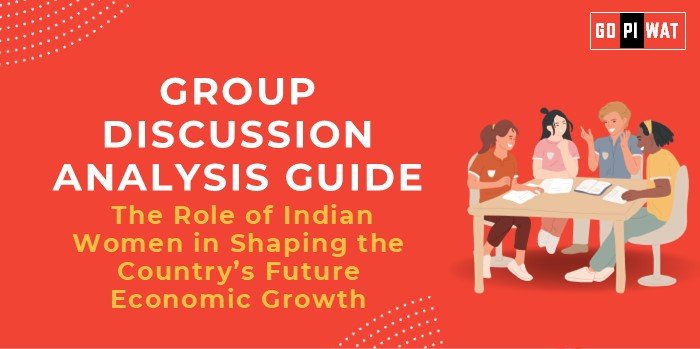📋 Group Discussion Analysis Guide
🌟 The Role of Indian Women in Shaping the Country’s Future Economic Growth
🌐 Introduction
India has made significant strides in enhancing the role of women in its economy. In 2023, the female Labor Force Participation Rate (LFPR) rose to 37.0%, showcasing growing economic engagement. However, challenges persist, and achieving gender parity remains essential for sustainable growth and realizing the $770 billion GDP boost by 2025.
📊 Quick Facts & Key Statistics
- Female Workforce Participation (2023): 37.0%, up from 32.3% in 2022, indicating progress in economic involvement.
- Potential GDP Boost: $770 billion could be added to GDP by 2025 with gender parity.
- Education Enrollment (2021-22): Women constitute 48% of higher education enrollments, totaling 2.07 crore.
- Entrepreneurship: Women own 13.5–15.7 million enterprises, representing 20% of all businesses, contributing to job creation and economic growth.
👥 Stakeholders and Their Roles
- Government: Establishing gender-specific policies like Stand-Up India, promoting education, and implementing labor reforms.
- Private Sector: Creating gender-inclusive workplaces, fostering leadership roles for women, and supporting entrepreneurs.
- Civil Society: Advocating for gender equity and supporting community-led initiatives for women’s economic empowerment.
- International Organizations: Providing funding and expertise for women-focused programs under SDG 5 (Gender Equality).
📈 Achievements and Challenges
🏆 Achievements
- Labor Force Inclusion: LFPR for women rose by nearly 5 percentage points from 2022 to 2023.
- Education Access: Women constitute almost half of higher education enrollments.
- Entrepreneurial Growth: Women-led businesses account for 20% of enterprises, driving innovation and employment.
⚠️ Challenges
- Wage Gap: Women earn 19% less than men for similar work.
- Cultural Barriers: Societal norms still limit opportunities for many women.
- Economic Inequities: Urban-rural divide in women’s access to jobs and resources.
🌍 Global Comparisons
- Nordic Countries: High LFPR and GDP contributions due to progressive policies.
- Bangladesh: Outpaces India in workforce inclusion due to targeted industry efforts like textiles.
📖 Case Studies
- Kerala Model: Nearly 50% of women in the workforce, driven by universal education and effective local governance.
🗣 Effective Discussion Approaches
- Opening Approaches:
- Data-Driven Start: Highlight the $770 billion GDP potential with gender parity.
- Global Benchmarking: Mention Nordic success in gender inclusion.
- Case Study Focus: Cite Kerala’s achievements in workforce participation.
- Counter-Argument Handling:
- Present success stories of women entrepreneurs overcoming barriers.
- Emphasize the multiplier effect of education and skill-building programs.
📊 Strategic Analysis of Strengths & Weaknesses
- Strengths: Increasing education levels, entrepreneurial spirit.
- Weaknesses: Persistent wage gaps, underrepresentation in STEM fields.
- Opportunities: Expansion of women-led enterprises, skilling programs in rural areas.
- Threats: Gender biases, lack of safety in public spaces.
📚 Structured Arguments for Discussion
- Supporting Stance: “The rise in female LFPR and growing entrepreneurial efforts indicate significant potential for boosting economic growth.”
- Opposing Stance: “Cultural and institutional barriers limit the extent of women’s contributions despite recent progress.”
- Balanced Perspective: “While women’s economic participation is growing, systemic changes are necessary to sustain and scale these gains.”
🎓 Connecting with B-School Applications
- Real-World Applications: Gender-diverse leadership studies, CSR initiatives for workplace equality.
- Sample Questions:
- “How can India address wage disparities to encourage higher female workforce participation?”
- “What role do women entrepreneurs play in fostering economic resilience?”
- Insights: Women’s inclusion fosters innovation and resilience in business.


